2018 NISSAN 370Z ignition
[x] Cancel search: ignitionPage 376 of 453
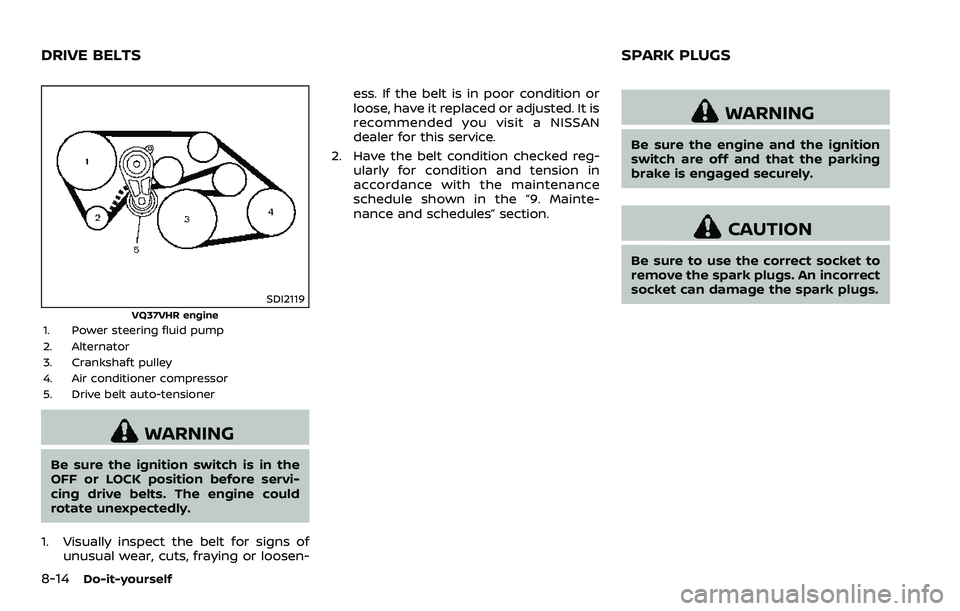
8-14Do-it-yourself
SDI2119VQ37VHR engine1. Power steering fluid pump
2. Alternator
3. Crankshaft pulley
4. Air conditioner compressor
5. Drive belt auto-tensioner
WARNING
Be sure the ignition switch is in the
OFF or LOCK position before servi-
cing drive belts. The engine could
rotate unexpectedly.
1. Visually inspect the belt for signs of unusual wear, cuts, fraying or loosen- ess. If the belt is in poor condition or
loose, have it replaced or adjusted. It is
recommended you visit a NISSAN
dealer for this service.
2. Have the belt condition checked reg- ularly for condition and tension in
accordance with the maintenance
schedule shown in the “9. Mainte-
nance and schedules” section.
WARNING
Be sure the engine and the ignition
switch are off and that the parking
brake is engaged securely.
CAUTION
Be sure to use the correct socket to
remove the spark plugs. An incorrect
socket can damage the spark plugs.
DRIVE BELTS SPARK PLUGS
Page 380 of 453
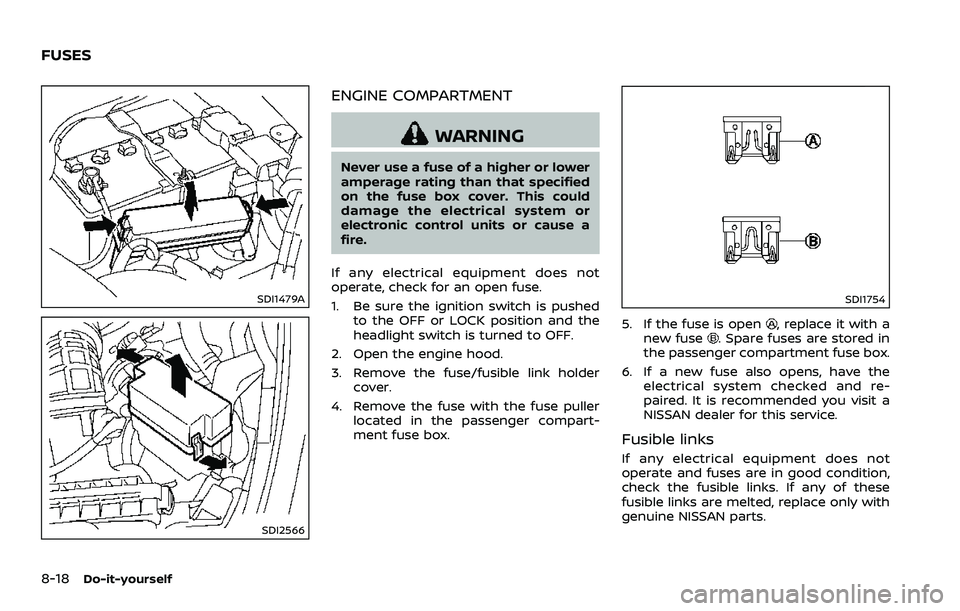
8-18Do-it-yourself
SDI1479A
SDI2566
ENGINE COMPARTMENT
WARNING
Never use a fuse of a higher or lower
amperage rating than that specified
on the fuse box cover. This could
damage the electrical system or
electronic control units or cause a
fire.
If any electrical equipment does not
operate, check for an open fuse.
1. Be sure the ignition switch is pushed to the OFF or LOCK position and the
headlight switch is turned to OFF.
2. Open the engine hood.
3. Remove the fuse/fusible link holder cover.
4. Remove the fuse with the fuse puller located in the passenger compart-
ment fuse box.
SDI1754
5. If the fuse is open, replace it with a
new fuse. Spare fuses are stored in
the passenger compartment fuse box.
6. If a new fuse also opens, have the electrical system checked and re-
paired. It is recommended you visit a
NISSAN dealer for this service.
Fusible links
If any electrical equipment does not
operate and fuses are in good condition,
check the fusible links. If any of these
fusible links are melted, replace only with
genuine NISSAN parts.
FUSES
Page 381 of 453
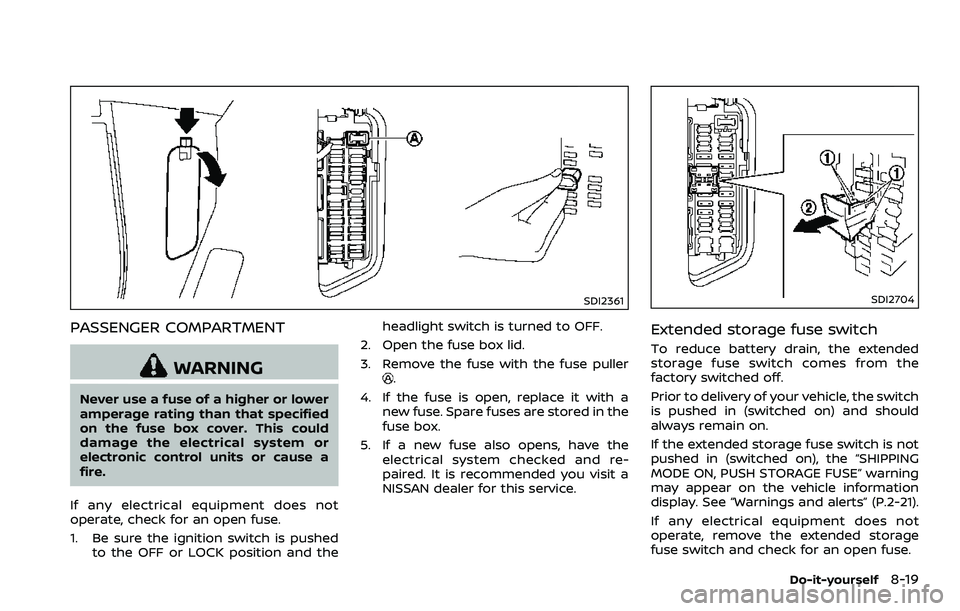
SDI2361
PASSENGER COMPARTMENT
WARNING
Never use a fuse of a higher or lower
amperage rating than that specified
on the fuse box cover. This could
damage the electrical system or
electronic control units or cause a
fire.
If any electrical equipment does not
operate, check for an open fuse.
1. Be sure the ignition switch is pushed to the OFF or LOCK position and the headlight switch is turned to OFF.
2. Open the fuse box lid.
3. Remove the fuse with the fuse puller
.
4. If the fuse is open, replace it with a new fuse. Spare fuses are stored in the
fuse box.
5. If a new fuse also opens, have the electrical system checked and re-
paired. It is recommended you visit a
NISSAN dealer for this service.
SDI2704
Extended storage fuse switch
To reduce battery drain, the extended
storage fuse switch comes from the
factory switched off.
Prior to delivery of your vehicle, the switch
is pushed in (switched on) and should
always remain on.
If the extended storage fuse switch is not
pushed in (switched on), the “SHIPPING
MODE ON, PUSH STORAGE FUSE” warning
may appear on the vehicle information
display. See “Warnings and alerts” (P.2-21).
If any electrical equipment does not
operate, remove the extended storage
fuse switch and check for an open fuse.
Do-it-yourself8-19
Page 382 of 453
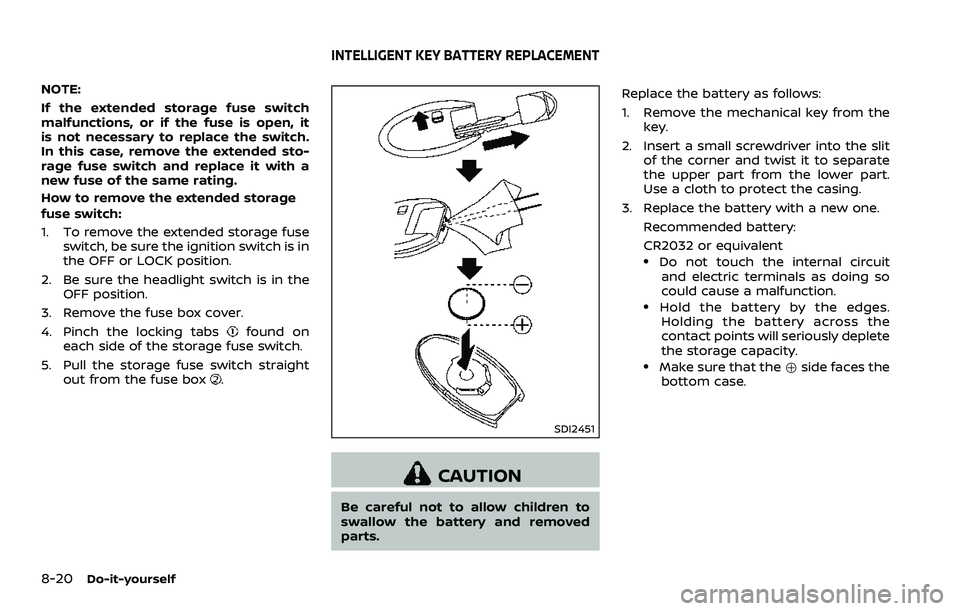
8-20Do-it-yourself
NOTE:
If the extended storage fuse switch
malfunctions, or if the fuse is open, it
is not necessary to replace the switch.
In this case, remove the extended sto-
rage fuse switch and replace it with a
new fuse of the same rating.
How to remove the extended storage
fuse switch:
1. To remove the extended storage fuseswitch, be sure the ignition switch is in
the OFF or LOCK position.
2. Be sure the headlight switch is in the OFF position.
3. Remove the fuse box cover.
4. Pinch the locking tabs
found on
each side of the storage fuse switch.
5. Pull the storage fuse switch straight out from the fuse box
.
SDI2451
CAUTION
Be careful not to allow children to
swallow the battery and removed
parts. Replace the battery as follows:
1. Remove the mechanical key from the
key.
2. Insert a small screwdriver into the slit of the corner and twist it to separate
the upper part from the lower part.
Use a cloth to protect the casing.
3. Replace the battery with a new one.
Recommended battery:
CR2032 or equivalent
.Do not touch the internal circuitand electric terminals as doing so
could cause a malfunction.
.Hold the battery by the edges.Holding the battery across the
contact points will seriously deplete
the storage capacity.
.Make sure that the +side faces the
bottom case.
INTELLIGENT KEY BATTERY REPLACEMENT
Page 424 of 453
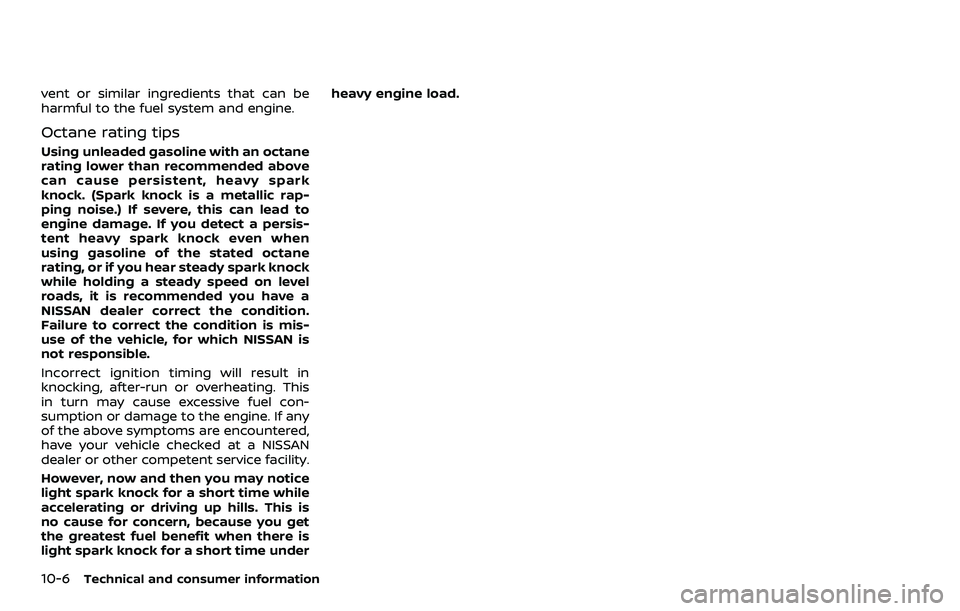
10-6Technical and consumer information
vent or similar ingredients that can be
harmful to the fuel system and engine.
Octane rating tips
Using unleaded gasoline with an octane
rating lower than recommended above
can cause persistent, heavy spark
knock. (Spark knock is a metallic rap-
ping noise.) If severe, this can lead to
engine damage. If you detect a persis-
tent heavy spark knock even when
using gasoline of the stated octane
rating, or if you hear steady spark knock
while holding a steady speed on level
roads, it is recommended you have a
NISSAN dealer correct the condition.
Failure to correct the condition is mis-
use of the vehicle, for which NISSAN is
not responsible.
Incorrect ignition timing will result in
knocking, after-run or overheating. This
in turn may cause excessive fuel con-
sumption or damage to the engine. If any
of the above symptoms are encountered,
have your vehicle checked at a NISSAN
dealer or other competent service facility.
However, now and then you may notice
light spark knock for a short time while
accelerating or driving up hills. This is
no cause for concern, because you get
the greatest fuel benefit when there is
light spark knock for a short time underheavy engine load.
Page 427 of 453

ENGINE
ModelVQ37VHR
Type Gasoline, 4-cycle
Cylinder arrangement 6-cylinder, V-slanted at 60°
Bore × Stroke in (mm) 3.760 × 3.385 (95.5 × 86.0)
Displacement cu in (cm
3) 225.54 (3,696)
Firing order 1-2-3-4-5-6
Idle speed rpm No adjustment is necessary.
Ignition timing (B.T.D.C.) degree/rpm
Spark plug Standard FXE24HR-11
Spark plug gap (Normal) in (mm) 0.043 (1.1)
Camshaft operation Timing chain
This spark ignition system complies
with the Canadian standard ICES-002.
STI0425
VQ37VHR engine
Technical and consumer information10-9
SPECIFICATIONS
Page 443 of 453
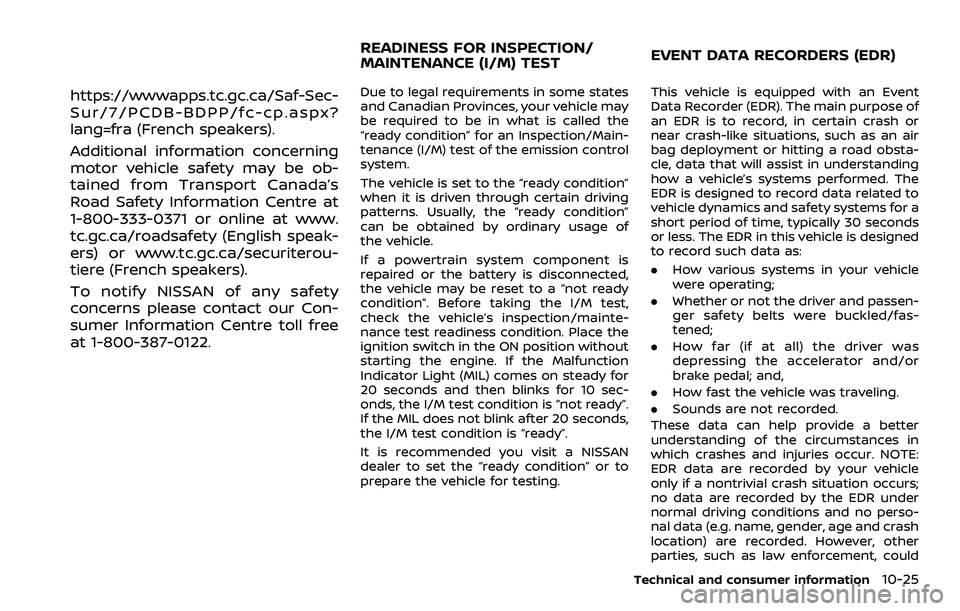
https://wwwapps.tc.gc.ca/Saf-Sec-
Sur/7/PCDB-BDPP/fc-cp.aspx?
lang=fra (French speakers).
Additional information concerning
motor vehicle safety may be ob-
tained from Transport Canada’s
Road Safety Information Centre at
1-800-333-0371 or online at www.
tc.gc.ca/roadsafety (English speak-
ers) or www.tc.gc.ca/securiterou-
tiere (French speakers).
To notify NISSAN of any safety
concerns please contact our Con-
sumer Information Centre toll free
at 1-800-387-0122.Due to legal requirements in some states
and Canadian Provinces, your vehicle may
be required to be in what is called the
“ready condition” for an Inspection/Main-
tenance (I/M) test of the emission control
system.
The vehicle is set to the “ready condition”
when it is driven through certain driving
patterns. Usually, the “ready condition”
can be obtained by ordinary usage of
the vehicle.
If a powertrain system component is
repaired or the battery is disconnected,
the vehicle may be reset to a “not ready
condition”. Before taking the I/M test,
check the vehicle’s inspection/mainte-
nance test readiness condition. Place the
ignition switch in the ON position without
starting the engine. If the Malfunction
Indicator Light (MIL) comes on steady for
20 seconds and then blinks for 10 sec-
onds, the I/M test condition is “not ready”.
If the MIL does not blink after 20 seconds,
the I/M test condition is “ready”.
It is recommended you visit a NISSAN
dealer to set the “ready condition” or to
prepare the vehicle for testing.This vehicle is equipped with an Event
Data Recorder (EDR). The main purpose of
an EDR is to record, in certain crash or
near crash-like situations, such as an air
bag deployment or hitting a road obsta-
cle, data that will assist in understanding
how a vehicle’s systems performed. The
EDR is designed to record data related to
vehicle dynamics and safety systems for a
short period of time, typically 30 seconds
or less. The EDR in this vehicle is designed
to record such data as:
.
How various systems in your vehicle
were operating;
. Whether or not the driver and passen-
ger safety belts were buckled/fas-
tened;
. How far (if at all) the driver was
depressing the accelerator and/or
brake pedal; and,
. How fast the vehicle was traveling.
. Sounds are not recorded.
These data can help provide a better
understanding of the circumstances in
which crashes and injuries occur. NOTE:
EDR data are recorded by your vehicle
only if a nontrivial crash situation occurs;
no data are recorded by the EDR under
normal driving conditions and no perso-
nal data (e.g. name, gender, age and crash
location) are recorded. However, other
parties, such as law enforcement, could
Technical and consumer information10-25
READINESS FOR INSPECTION/
MAINTENANCE (I/M) TEST EVENT DATA RECORDERS (EDR)
Page 447 of 453

Fuel economy........................................................... 5-25
Fuel economy information (display).......... 4-9
Fuel information...................................................... 10-4
Fuel octane rating ................................................. 10-4
Fuel-filler cap............................................................. 3-35
Fuel-filler door.......................................................... 3-35
Gauge........................................................................\
......... 2-8
LOOSE FUEL CAP warning.............................. 3-37
Fuel efficient driving tips ......................................... 5-24
Fuses........................................................................\
................ 8-18
Fusible links........................................................................\
8-18
G
Garage door opener, HomeLink®
Universal Transceiver ................................................. 2-52
Gas cap........................................................................\
.......... 3-35
Gauge........................................................................\
................. 2-5 Engine coolant temperature gauge.......... 2-7
Fuel gauge ..................................................................... 2-8
Odometer........................................................................\
2-6
Speedometer ............................................................... 2-6
Tachometer................................................................... 2-7
Trip computer .......................................................... 2-23
General maintenance.................................................... 9-2
Glove box ........................................................................\
..... 2-44
H
Hands-free phone system, Bluetooth®
(models with navigation system) ..................... 4-76
Hands-free phone system, Bluetooth®
(models without navigation system) ............ 4-86
Hatch, Rear hatch .......................................................... 3-18
Hazard warning flasher switch ............................. 6-2
Head restraints/headrests......................................... 1-6 Headlights
Bulb replacement .................................................. 8-23
Headlight switch .................................................... 2-34
Xenon headlights................................................... 2-34
Heated seats ..................................................................... 2-38
Heater Engine block heater ............................................ 5-34
Heater and air conditioner operation..... 4-25
HomeLink® Universal Transceiver .................... 2-52
Hood release ...................................................................... 3-17
Horn........................................................................\
.................. 2-38
I
Ignition switch (Push-button)............................................................... 5-8
Manual transmission models........................ 5-17
Immobilizer system..................................................... 2-30
In-cabin microfilter ...................................................... 4-30
Indicator lights.................................................................. 2-15
INFO button ........................................................................\
. 4-8
Inside mirror ...................................................................... 3-39
Inspection/maintenance (I/M) test .............. 10-25
Instrument brightness control ........................... 2-37
Instrument panel .............................................................. 2-4
Instrument pocket........................................................ 2-43
Intelligent Key...................................................................... 3-3
Intelligent Key battery
discharge indicator ..................................................... 2-20
Intelligent Key removal indicator..................... 2-20
Intelligent Key system .................................................. 3-7 Battery replacement........................................... 8-20
Intelligent Key system warning light ...... 2-12
Key operating range .............................................. 3-9
Key operation ............................................................ 3-10
Warning signals........................................................ 3-12
Interior light control switch ................................. 2-50 Interior light replacement....................................... 8-24
Interior lights.................................................................... 2-50
Interior trunk lid release ........................................... 3-21
iPod® player operation............................................. 4-68
J
Jump starting .................................................................... 6-15
K
Keyless entry (See remote keyless
entry system) ..................................................................... 3-14
Keys ........................................................................\
..................... 3-3
For Intelligent Key system................................. 3-7
L
LabelsAir bag warning labels ....................................... 1-44
Air conditioner specification label........... 10-14
Emission control information label........ 10-13
Engine serial number ........................................ 10-13
F.M.V.S.S./C.M.V.S.S.
certification label .................................................. 10-13
Tire and Loading
information label..................................... 8-27, 10-14
Vehicle identification number (VIN)........ 10-12
License plate, Installing front
license plate..................................................................... 10-15
Light
Air bag warning light........................................... 1-44
Bulb replacement .................................................. 8-22
Cargo area courtesy light................................ 2-51
Cargo light .................................................................. 2-52
Fog light switch ...................................................... 2-38
Headlight switch .................................................... 2-34
11-3